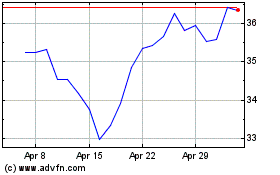By Laura Saunders
Investors seeking both high income and low taxes poured billions
of dollars into publicly traded energy master limited partnerships.
Now many have tax headaches -- surprisingly big bills from Uncle
Sam and return preparers.
Two new MLP deals, from Williams Companies Inc.. and Enbridge
Inc., are the latest to trigger these headaches. In these deals,
known as roll-ups, the corporation sponsoring an MLP pulls it back
into the corporate fold, and MLP investors exchange their units for
corporate stock.
These consolidations will provide tax and other benefits to the
parent corporations and their shareholders. Williams said that as a
result of the deal, it expects not to owe cash taxes through
2024.
But for these MLPs' investors, the deals are taxable and neither
one includes a cash payment to help with their own tax bills.
"In each case, the corporation and its investors will reap tax
benefits at the expense of one segment of stakeholders," says
Robert Willens, an independent tax analyst.
A spokesman for Williams disagreed with this assessment, citing
a premium to be received by MLP investors, among other things. A
spokesman for Enbridge referred investors to the deal's
announcement.
These consolidations once again show the downside of the
innovative MLP format. They were originally conceived as a way to
attract investment to income-producing energy assets like
pipelines. As partnerships, MLPs bypassed a layer of corporate
taxes, and high depreciation plus special breaks helped defer taxes
on hefty income payouts.
These features drew investors craving income, many of whom
ignored MLPs' tax complexities. Some planned to hold their units
until death, when messy issues often disappear because of favorable
tax provisions.
However, many MLP investors haven't been able to hold that long.
Some corporate sponsors cooled to MLPs when the structure became
burdensome to growth. In 2014, Kinder Morgan Inc. consolidated two
affiliated MLPs that were widely held by investors in a
reorganization that was taxable to the investors.
The latest two hiccups for MLP investors both occurred on May
17. Tulsa-based Williams said it would acquire the remaining 256
million units of its affiliated MLP, Williams Partners. Investors
will receive nearly 1.5 shares in the parent for each unit they
own. Calgary-based Enbridge announced it would exchange company
stock, in different ratios, for units of two affiliated MLPs.
The two companies both cited a March 15 ruling by the Federal
Energy Regulatory Commission that denies a tax benefit previously
allowed to MLPs. This reduces profits and further tilts the scales
against the MLP format for some pipelines.
To be fair, MLPs have performed well for many investors. But
when units must be sold, the act of selling often brings a complex
and costly reckoning with the Internal Revenue Service.
"In the end, many MLP investors don't do as well as they
expected to," says Mark Cook, a CPA with SingerLewak in Irvine,
Calif.
For those facing an MLP roll-up, here are tips for the road
ahead.
Determine the cost. The starting point for measuring an
investment's taxable gain or loss is its purchase price plus
adjustments, known as "cost basis." With a stock this is often the
purchase price. But figuring the correct basis for partnerships
such as MLPs is usually complex because they pass income and
deductions directly through to their investors.
This means that MLP units often have many adjustments to their
purchase price. For example, income raises a unit's cost basis,
while depreciation and losses lower it. The partnership reports
annual adjustments to investors on a Schedule K-1 -- be sure to
keep these records.
Tracking adjustments is often tedious. A spokesman for Williams
said that a calculator on its website can help determine results
through 2017, but it doesn't yet include results for 2018.
Figure the gains or loss from the sale. The investor's net
results can include both profits and losses.
Net profits are typically taxable as capital gains, which can
qualify for lower rates, or as ordinary income, which is usually
taxed at higher rates. Losses are generally capital losses.
After an MLP sale, say Mr. Willens and Mr. Cook, some investors
wind up with an unwelcome tax result: large gains taxed at higher
ordinary income rates, and capital losses that can't be used to
offset them.
Don't donate. Some investors dealing with MLP complexity look to
donate units to charity, as they would a long-held stock. This
strategy seldom makes sense. Unlike with stock shares, the donor
usually can't deduct the full market value of the MLP units.
Cope with IRA issues. Tax specialists warn against putting MLP
units in individual retirement accounts or Roth IRAs, because
certain income could be taxable even though the account is
tax-exempt. Many investors don't owe this levy annually because the
taxable income falls below the limit of $1,000 per IRA.
However, a sale of all MLP units held by an IRA could trigger
substantial taxable income for IRA owners, says Mr. Cook.
Settle up. In addition to tax due, the IRS requires a special
statement from MLP investors in the year of a sale, breaking out
capital gains and ordinary income earned. Janet Hagy, a CPA in
Austin, Texas, warns that tax-prep software often lacks the proper
form.
She adds that preparing taxes for MLP units is so time consuming
that investors should expect tax-prep bills to rise by 200% to
300%.
Write to Laura Saunders at laura.saunders@wsj.com
(END) Dow Jones Newswires
May 25, 2018 05:44 ET (09:44 GMT)
Copyright (c) 2018 Dow Jones & Company, Inc.
Enbridge (NYSE:ENB)
Historical Stock Chart
From Mar 2024 to Apr 2024

Enbridge (NYSE:ENB)
Historical Stock Chart
From Apr 2023 to Apr 2024
